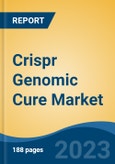Free Webex Call
The Crispr Genomic Cure Market was valued at USD 2.95 Billion in 2024, and is expected to reach USD 11.36 Billion by 2030, rising at a CAGR of 25.15%. The global CRISPR genomic cure market is a rapidly evolving sector within the biotechnology and healthcare industries. CRISPR (Clustered Regularly Interspaced Short Palindromic Repeats) technology has revolutionized gene editing and holds immense promise for treating various genetic and hereditary diseases. Speak directly to the analyst to clarify any post sales queries you may have.
10% Free customizationThis report comes with 10% free customization, enabling you to add data that meets your specific business needs.
Key Market Drivers
Increasing Prevalence of Genetic Disorders and Chronic Diseases
The growing incidence of genetic disorders and chronic diseases is a major driver behind the rapid expansion of the Global CRISPR Genomic Cure Market. Genetic disorders and congenital abnormalities affect approximately 2%-5% of all live births, contributing to up to 30% of pediatric hospital admissions and accounting for nearly 50% of childhood mortality in industrialized nations. These figures highlight a critical demand for advanced genomic interventions, positioning CRISPR-based therapies as a transformative solution in pediatric healthcare.As the burden of hereditary and chronic illnesses continues to rise worldwide, there is an increasing demand for innovative, targeted, and long-term solutions to treat these conditions. CRISPR-based gene editing has emerged as a groundbreaking approach, offering precise and potentially curative treatments for diseases with a strong genetic basis. The incidence of genetic disorders and chronic diseases is increasing due to factors such as aging populations, environmental influences, and inherited genetic mutations. Annually,
Key Market Challenges
Ethical and Regulatory Hurdles
Perhaps one of the most significant challenges is the ethical and regulatory landscape surrounding CRISPR technology. The ethical debate over gene editing in humans, particularly germline editing, remains a contentious issue. Regulatory agencies worldwide are grappling with the need to strike a balance between fostering innovation and ensuring safety and ethical considerations.Key Market Players
- Merck KGaA
- Takara Bio Inc
- Lonza Group AG
- Horizon Discovery Group Ltd
- Genscript Biotech Corp
- Synthego Corp
- Precision BioSciences Inc
- Mammoth Biosciences Inc
- Thermo Fisher Scientific Inc
- Intellia Therapeutics Inc
Report Scope:
In this report, the Global Crispr Genomic Cure Market has been segmented into the following categories, in addition to the industry trends which have also been detailed below:Crispr Genomic Cure Market, By Disease Type:
- Genetic Disorders
- Cancer
- Infectious Diseases
- Neurological Disorders
- Cardiovascular Disorders
- Blood Disorders
- Metabolic Disorders
- Others
Crispr Genomic Cure Market, By Therapy Type:
- Gene Editing
- Gene Therapy
- Cell Therapy
- Immunotherapy
Crispr Genomic Cure Market, By Delivery Method:
- In vivo
- Ex vivo
Crispr Genomic Cure Market, By End User:
- Hospitals & Clinics
- Research Institutes
- Biotechnology & Pharmaceutical Companies
Crispr Genomic Cure Market, By Targeted Genetic Modification:
- Single Gene Modification
- Multiple Gene Modification
- Genome-wide Modification
Crispr Genomic Cure Market, By Region:
- North America
- United States
- Canada
- Mexico
- Europe
- Germany
- United Kingdom
- France
- Italy
- Spain
- Asia-Pacific
- China
- Japan
- India
- Australia
- South Korea
- South America
- Brazil
- Argentina
- Colombia
- Middle East & Africa
- South Africa
- Saudi Arabia
- UAE
Competitive Landscape
Company Profiles: Detailed analysis of the major companies present in the Global Crispr Genomic Cure Market.Available Customizations:
With the given market data, the publisher offers customizations according to a company's specific needs. The following customization options are available for the report.Company Information
- Detailed analysis and profiling of additional market players (up to five).
This product will be delivered within 1-3 business days.
Table of Contents
1. Product Overview
2. Research Methodology
3. Executive Summary
5. Crispr Genomic Cure Market Outlook
6. North America Crispr Genomic Cure Market Outlook
7. Europe Crispr Genomic Cure Market Outlook
8. Asia-Pacific Crispr Genomic Cure Market Outlook
9. South America Crispr Genomic Cure Market Outlook
10. Middle East and Africa Crispr Genomic Cure Market Outlook
11. Market Dynamics
12. Market Trends & Developments
14. Competitive Landscape
Companies Mentioned
- Merck KGaA
- Takara Bio Inc
- Lonza Group AG
- Horizon Discovery Group Ltd
- Genscript Biotech Corp
- Synthego Corp
- Precision BioSciences Inc
- Mammoth Biosciences Inc
- Thermo Fisher Scientific Inc
- Intellia Therapeutics Inc
Table Information
| Report Attribute | Details |
|---|---|
| No. of Pages | 180 |
| Published | February 2025 |
| Forecast Period | 2024 - 2030 |
| Estimated Market Value ( USD | $ 2.95 Billion |
| Forecasted Market Value ( USD | $ 11.36 Billion |
| Compound Annual Growth Rate | 25.1% |
| Regions Covered | Global |
| No. of Companies Mentioned | 10 |









